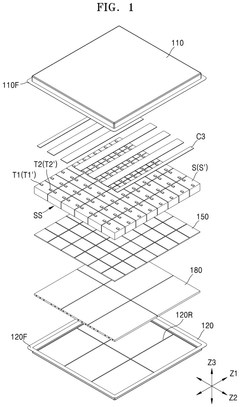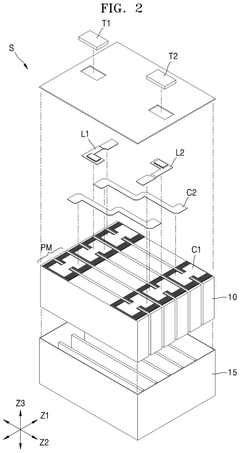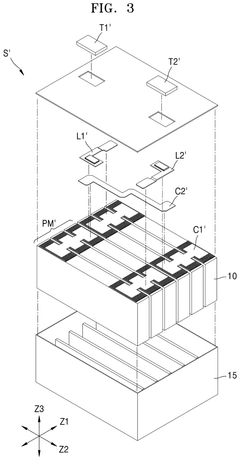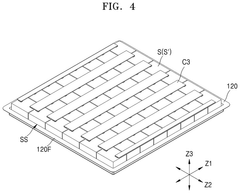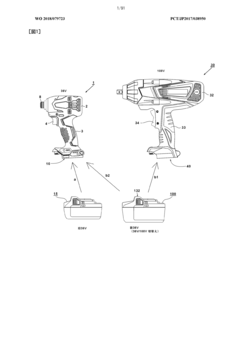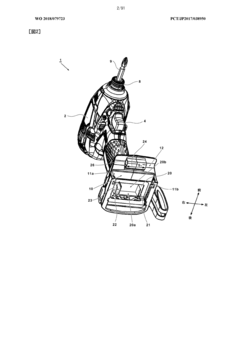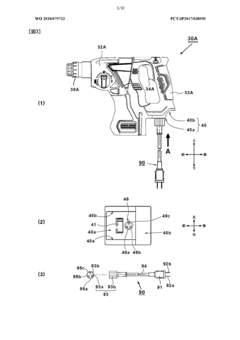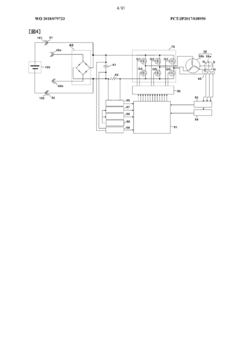Adaptive Battery Pack Design for Variable Grid Storage Needs
SEP 23, 20259 MIN READ
Generate Your Research Report Instantly with AI Agent
Patsnap Eureka helps you evaluate technical feasibility & market potential.
Energy Storage Evolution and Objectives
Energy storage technologies have undergone significant evolution over the past decades, transitioning from rudimentary lead-acid batteries to sophisticated lithium-ion systems and emerging alternatives. This progression has been driven by increasing demands for grid stability, renewable energy integration, and the need for more efficient and sustainable power management solutions. The historical trajectory shows a clear pattern of increasing energy density, longer cycle life, and improved safety features across various storage technologies.
The grid storage landscape has transformed dramatically with the proliferation of renewable energy sources such as solar and wind power. These intermittent generation methods have created unprecedented challenges for grid operators, necessitating advanced storage solutions that can respond dynamically to fluctuating supply and demand patterns. Traditional battery systems designed for fixed applications are increasingly inadequate for modern grid requirements that demand adaptability and scalability.
Adaptive battery pack design represents a critical technological frontier that aims to address the variable needs of modern electrical grids. Unlike conventional fixed-capacity storage systems, adaptive designs incorporate modular architectures, intelligent power management, and flexible configuration capabilities. These features enable real-time adjustment to changing grid conditions, optimizing performance across diverse operational scenarios while maximizing resource utilization.
The primary objectives for adaptive battery storage development include achieving dynamic capacity scaling, enhancing response times to grid fluctuations, extending operational lifespans through intelligent load distribution, and reducing total cost of ownership. Additionally, these systems must maintain reliability under varying environmental conditions while accommodating different battery chemistries to leverage technological advancements as they emerge.
Current technological trends point toward increasingly sophisticated battery management systems (BMS) that incorporate machine learning algorithms to predict grid demands and optimize battery performance accordingly. These systems aim to balance competing priorities such as immediate power availability, long-term capacity preservation, thermal management, and economic considerations in real-time operational contexts.
Looking forward, the evolution of adaptive battery storage will likely focus on greater integration with smart grid technologies, enhanced predictive capabilities, and improved interoperability between diverse energy storage mediums. The ultimate goal is to create resilient, self-optimizing storage networks that can seamlessly adjust to both short-term fluctuations and long-term changes in energy production and consumption patterns, thereby supporting the transition to a more sustainable and reliable energy infrastructure.
The grid storage landscape has transformed dramatically with the proliferation of renewable energy sources such as solar and wind power. These intermittent generation methods have created unprecedented challenges for grid operators, necessitating advanced storage solutions that can respond dynamically to fluctuating supply and demand patterns. Traditional battery systems designed for fixed applications are increasingly inadequate for modern grid requirements that demand adaptability and scalability.
Adaptive battery pack design represents a critical technological frontier that aims to address the variable needs of modern electrical grids. Unlike conventional fixed-capacity storage systems, adaptive designs incorporate modular architectures, intelligent power management, and flexible configuration capabilities. These features enable real-time adjustment to changing grid conditions, optimizing performance across diverse operational scenarios while maximizing resource utilization.
The primary objectives for adaptive battery storage development include achieving dynamic capacity scaling, enhancing response times to grid fluctuations, extending operational lifespans through intelligent load distribution, and reducing total cost of ownership. Additionally, these systems must maintain reliability under varying environmental conditions while accommodating different battery chemistries to leverage technological advancements as they emerge.
Current technological trends point toward increasingly sophisticated battery management systems (BMS) that incorporate machine learning algorithms to predict grid demands and optimize battery performance accordingly. These systems aim to balance competing priorities such as immediate power availability, long-term capacity preservation, thermal management, and economic considerations in real-time operational contexts.
Looking forward, the evolution of adaptive battery storage will likely focus on greater integration with smart grid technologies, enhanced predictive capabilities, and improved interoperability between diverse energy storage mediums. The ultimate goal is to create resilient, self-optimizing storage networks that can seamlessly adjust to both short-term fluctuations and long-term changes in energy production and consumption patterns, thereby supporting the transition to a more sustainable and reliable energy infrastructure.
Grid Storage Market Analysis
The global grid storage market has experienced significant growth in recent years, driven by the increasing integration of renewable energy sources and the need for grid stability. As of 2023, the market size has reached approximately 30 billion USD, with projections indicating a compound annual growth rate (CAGR) of 24% through 2030. This remarkable expansion reflects the critical role that energy storage systems play in modern electrical infrastructure.
Lithium-ion batteries currently dominate the grid storage landscape, accounting for roughly 70% of newly installed capacity. However, alternative technologies such as flow batteries, compressed air energy storage, and gravity-based systems are gaining traction in specific application scenarios. The market segmentation reveals distinct requirements across different regions and use cases, highlighting the need for adaptive battery solutions.
Utility-scale applications represent the largest market segment, comprising about 65% of total deployments. These installations primarily serve peak shaving, frequency regulation, and renewable integration functions. Commercial and industrial applications constitute approximately 25% of the market, while residential systems account for the remaining 10%. Each segment presents unique demands regarding discharge duration, cycle life, and response time.
Geographically, North America and Asia-Pacific lead in grid storage deployments, with Europe showing accelerated adoption rates. China has emerged as both the largest manufacturer and consumer of grid storage technologies, while the United States maintains leadership in technological innovation and system integration. Developing markets in India, Southeast Asia, and parts of Africa are experiencing rapid growth as they seek to improve grid reliability and expand access to electricity.
Market drivers include declining battery costs, which have decreased by over 85% in the past decade, alongside supportive government policies and renewable energy targets. The increasing frequency of extreme weather events has further emphasized the value of resilient grid infrastructure, boosting demand for storage solutions. Corporate sustainability commitments and the electrification of transportation are creating additional market opportunities.
Key challenges facing the grid storage market include supply chain constraints for critical minerals, regulatory uncertainties, and interconnection bottlenecks. The variability in grid requirements across different regions necessitates customizable storage solutions that can adapt to specific needs. This market condition directly informs the demand for adaptive battery pack designs that can efficiently address the diverse and evolving requirements of grid operators worldwide.
Lithium-ion batteries currently dominate the grid storage landscape, accounting for roughly 70% of newly installed capacity. However, alternative technologies such as flow batteries, compressed air energy storage, and gravity-based systems are gaining traction in specific application scenarios. The market segmentation reveals distinct requirements across different regions and use cases, highlighting the need for adaptive battery solutions.
Utility-scale applications represent the largest market segment, comprising about 65% of total deployments. These installations primarily serve peak shaving, frequency regulation, and renewable integration functions. Commercial and industrial applications constitute approximately 25% of the market, while residential systems account for the remaining 10%. Each segment presents unique demands regarding discharge duration, cycle life, and response time.
Geographically, North America and Asia-Pacific lead in grid storage deployments, with Europe showing accelerated adoption rates. China has emerged as both the largest manufacturer and consumer of grid storage technologies, while the United States maintains leadership in technological innovation and system integration. Developing markets in India, Southeast Asia, and parts of Africa are experiencing rapid growth as they seek to improve grid reliability and expand access to electricity.
Market drivers include declining battery costs, which have decreased by over 85% in the past decade, alongside supportive government policies and renewable energy targets. The increasing frequency of extreme weather events has further emphasized the value of resilient grid infrastructure, boosting demand for storage solutions. Corporate sustainability commitments and the electrification of transportation are creating additional market opportunities.
Key challenges facing the grid storage market include supply chain constraints for critical minerals, regulatory uncertainties, and interconnection bottlenecks. The variability in grid requirements across different regions necessitates customizable storage solutions that can adapt to specific needs. This market condition directly informs the demand for adaptive battery pack designs that can efficiently address the diverse and evolving requirements of grid operators worldwide.
Battery Technology Challenges
Despite significant advancements in battery technology over the past decade, several critical challenges persist in developing adaptive battery pack designs for variable grid storage needs. The primary technical hurdle remains energy density limitations, with current lithium-ion technologies reaching theoretical limits around 250-300 Wh/kg, insufficient for large-scale grid applications requiring multi-megawatt-hour capacity in space-constrained environments.
Cycle life degradation presents another significant challenge, particularly for grid storage applications where batteries may undergo multiple daily charge-discharge cycles. Current technologies typically deliver 1,000-3,000 cycles before capacity falls below 80%, translating to just 3-8 years of operational life—inadequate for infrastructure investments requiring 15-20 year returns.
Thermal management remains critically unresolved, especially for large-scale battery installations where heat dissipation becomes exponentially more complex. Inadequate thermal control can trigger thermal runaway events, posing serious safety risks and accelerating degradation in grid-scale implementations.
Cost barriers continue to impede widespread adoption, with current lithium-ion systems averaging $150-300/kWh. While this represents a 90% reduction from 2010 prices, grid storage applications require further cost reductions to $50-75/kWh to achieve economic viability without subsidies.
Scalability challenges emerge when transitioning from kilowatt to megawatt-hour systems, as battery management systems must coordinate thousands of individual cells while maintaining balanced performance. Current BMS architectures struggle with the computational demands of real-time monitoring and predictive analytics at grid scale.
Resource constraints and supply chain vulnerabilities present long-term sustainability concerns, particularly regarding critical materials like lithium, cobalt, and nickel. Geopolitical concentration of these resources introduces significant supply risk for large-scale deployment.
Standardization gaps further complicate integration, as the absence of universal protocols for grid-connected battery systems creates interoperability challenges between different manufacturers' components and existing grid infrastructure.
Regulatory uncertainty regarding safety standards, grid connection requirements, and end-of-life management creates additional barriers to implementation, with fragmented approaches across different jurisdictions increasing compliance complexity for adaptive battery systems designed for variable grid applications.
Cycle life degradation presents another significant challenge, particularly for grid storage applications where batteries may undergo multiple daily charge-discharge cycles. Current technologies typically deliver 1,000-3,000 cycles before capacity falls below 80%, translating to just 3-8 years of operational life—inadequate for infrastructure investments requiring 15-20 year returns.
Thermal management remains critically unresolved, especially for large-scale battery installations where heat dissipation becomes exponentially more complex. Inadequate thermal control can trigger thermal runaway events, posing serious safety risks and accelerating degradation in grid-scale implementations.
Cost barriers continue to impede widespread adoption, with current lithium-ion systems averaging $150-300/kWh. While this represents a 90% reduction from 2010 prices, grid storage applications require further cost reductions to $50-75/kWh to achieve economic viability without subsidies.
Scalability challenges emerge when transitioning from kilowatt to megawatt-hour systems, as battery management systems must coordinate thousands of individual cells while maintaining balanced performance. Current BMS architectures struggle with the computational demands of real-time monitoring and predictive analytics at grid scale.
Resource constraints and supply chain vulnerabilities present long-term sustainability concerns, particularly regarding critical materials like lithium, cobalt, and nickel. Geopolitical concentration of these resources introduces significant supply risk for large-scale deployment.
Standardization gaps further complicate integration, as the absence of universal protocols for grid-connected battery systems creates interoperability challenges between different manufacturers' components and existing grid infrastructure.
Regulatory uncertainty regarding safety standards, grid connection requirements, and end-of-life management creates additional barriers to implementation, with fragmented approaches across different jurisdictions increasing compliance complexity for adaptive battery systems designed for variable grid applications.
Current Adaptive Battery Solutions
01 Modular battery pack design for adaptability
Modular battery pack designs allow for flexible configuration and adaptation to different devices or power requirements. These systems feature interchangeable battery modules that can be added, removed, or rearranged based on specific needs. The modular approach enables customization of capacity, voltage, and physical dimensions, making the battery pack adaptable to various applications while optimizing space utilization and weight distribution.- Battery pack configuration adaptability: Adaptive battery packs can be configured to accommodate different device requirements through modular designs that allow for flexible arrangement of battery cells. These configurations enable the battery pack to adapt to various form factors, power requirements, and usage scenarios. The adaptability in configuration enhances compatibility across multiple devices and applications, optimizing space utilization while maintaining performance.
- Dynamic power management systems: Advanced battery packs incorporate dynamic power management systems that can adapt to changing power demands in real-time. These systems monitor usage patterns, adjust power output based on load requirements, and optimize energy distribution to extend battery life. The intelligent management systems can prioritize critical functions during low power situations and balance performance with energy conservation based on operational conditions.
- Thermal adaptability mechanisms: Adaptive battery packs include thermal management features that respond to temperature variations to maintain optimal operating conditions. These mechanisms can include active cooling systems, heat dissipation structures, and temperature-sensitive controls that adjust charging and discharging rates. By adapting to thermal conditions, these battery packs can prevent overheating, extend battery lifespan, and ensure consistent performance across various environmental conditions.
- Multi-chemistry compatibility: Modern adaptive battery packs are designed to accommodate multiple battery chemistries within a single system. This adaptability allows for optimization based on specific application needs, combining different cell types to balance energy density, power output, and longevity. The multi-chemistry approach enables manufacturers to create hybrid solutions that leverage the strengths of various battery technologies while mitigating their individual limitations.
- Smart charging and discharging adaptability: Adaptive battery packs feature intelligent charging and discharging capabilities that adjust to power source availability and device requirements. These systems can modify charging protocols based on input power quality, adapt to various charging standards, and implement optimized discharge profiles for different operational modes. The smart adaptability extends battery life by preventing harmful charging patterns and ensures efficient power delivery across diverse usage scenarios.
02 Adaptive battery management systems
Advanced battery management systems that dynamically adjust charging, discharging, and thermal management parameters based on real-time conditions and usage patterns. These systems employ sophisticated algorithms to monitor battery health, optimize performance, and extend battery life by adapting to changing environmental conditions, load requirements, and aging characteristics. The adaptive management approach ensures optimal battery operation across various scenarios while maintaining safety and reliability.Expand Specific Solutions03 Reconfigurable battery architecture
Battery packs with reconfigurable internal architecture that can adapt their electrical configuration (series/parallel connections) in response to changing power demands or fault conditions. These systems can dynamically alter their voltage and current output characteristics through electronic switching networks, allowing a single battery pack to serve multiple applications or adapt to changing load requirements. This reconfigurability enhances versatility and resilience while optimizing energy delivery efficiency.Expand Specific Solutions04 Adaptive thermal management solutions
Specialized thermal management systems that adapt to changing thermal conditions to maintain optimal battery temperature across various operating environments. These solutions incorporate temperature sensors, active cooling/heating elements, and control algorithms to respond to both internal heat generation and external temperature fluctuations. Adaptive thermal management prevents performance degradation, extends battery life, and enhances safety by maintaining cells within their optimal temperature range regardless of usage intensity or ambient conditions.Expand Specific Solutions05 Smart interface and compatibility systems
Intelligent interface systems that enable battery packs to adapt to different devices through automatic detection and configuration. These systems feature adaptive connectors, communication protocols, and power delivery mechanisms that can identify host device requirements and adjust accordingly. The smart interfaces allow a single battery pack to be compatible with multiple devices or generations of products, enhancing versatility and reducing the need for device-specific battery solutions.Expand Specific Solutions
Key Industry Players
The adaptive battery pack design market for variable grid storage is in its growth phase, with increasing demand driven by renewable energy integration challenges. The market is expanding rapidly, projected to reach significant scale as grid modernization accelerates. Technologically, the field shows varying maturity levels across players. Industry leaders like LG Energy Solution, Samsung SDI, and Northvolt demonstrate advanced capabilities in scalable battery systems, while State Grid Corp. of China and Robert Bosch are leveraging their infrastructure expertise to develop adaptive solutions. Emerging innovators such as Xerotech and CTNS are introducing modular architectures that allow dynamic reconfiguration based on grid demands. The competitive landscape features both established energy storage providers and specialized newcomers focusing on flexibility and grid integration.
LG Energy Solution Ltd.
Technical Solution: LG Energy Solution has developed a modular adaptive battery storage system that can dynamically adjust to grid demands. Their technology incorporates smart Battery Management Systems (BMS) that enable real-time capacity adjustment based on grid requirements. The system features stackable battery modules with independent control circuits that can be activated or deactivated based on demand forecasting algorithms. LG's solution includes predictive analytics that anticipate grid fluctuations and automatically reconfigure the battery array to optimize for either power output or energy storage duration. Their adaptive battery packs incorporate thermal management systems that adjust cooling/heating based on operational demands, extending battery life while maintaining performance under variable load conditions.
Strengths: Advanced BMS with predictive capabilities allows for precise grid response; modular design enables scalability and redundancy. Weaknesses: Higher initial implementation costs compared to static systems; requires sophisticated grid integration infrastructure to fully utilize adaptive capabilities.
State Grid Corp. of China
Technical Solution: State Grid Corporation of China has pioneered a large-scale adaptive battery storage solution designed specifically for grid-level implementation. Their technology features a distributed battery architecture that can be dynamically reconfigured based on grid conditions. The system employs AI-driven load prediction algorithms that analyze historical usage patterns, weather forecasts, and real-time demand to optimize battery configuration. State Grid's solution incorporates multiple battery chemistries within a single installation, allowing the system to prioritize different battery types based on specific grid needs (frequency regulation, peak shaving, or long-duration backup). Their adaptive management platform enables remote reconfiguration of battery arrays across multiple sites, creating a virtual power plant that can respond to regional grid variations.
Strengths: Massive deployment capability with proven integration into existing grid infrastructure; comprehensive data analytics from nationwide grid operations inform adaptive algorithms. Weaknesses: System complexity requires significant technical expertise for maintenance; standardization challenges when implementing across diverse regional grids.
Core Battery Management Innovations
Battery pack
PatentPendingUS20250239703A1
Innovation
- A battery pack design featuring unit cells with serial-parallel current collector connections, individualized unit cooling plates, and heat transfer sheets for uniform cooling, along with a simplified electrical connection structure.
Battery pack, electrical device using battery pack, and electrical device system
PatentWO2018079723A1
Innovation
- A battery pack design featuring a voltage switching element that allows output voltage to be switched between series and parallel connections, enabling compatibility with various electrical devices and safe transportation by disconnecting cell units when necessary.
Regulatory Framework for Grid Storage
The regulatory landscape for grid storage technologies, particularly adaptive battery systems, is complex and evolving rapidly across different jurisdictions. In the United States, FERC Order 841 represents a landmark regulation that opened wholesale electricity markets to energy storage resources, creating significant opportunities for adaptive battery pack designs. This regulation mandates that grid operators develop participation models allowing storage resources to provide all services they are technically capable of delivering, which has accelerated the deployment of variable-capacity storage solutions.
The European Union has established the Clean Energy Package, which includes specific provisions for energy storage within its electricity market design directive. These regulations recognize storage as a distinct asset class and prohibit network operators from owning storage facilities except under specific circumstances. This regulatory framework has encouraged the development of adaptive battery systems that can respond to varying grid needs while maintaining compliance with ownership restrictions.
At the national level, countries have implemented diverse regulatory approaches. Germany's Energy Industry Act (EnWG) provides a legal framework for storage facilities, while the UK's Capacity Market includes specific provisions for battery storage participation. These regulations often include technical requirements for grid connection, safety standards, and performance metrics that adaptive battery systems must meet.
Environmental regulations also significantly impact battery storage deployment. The EU Battery Directive and similar regulations in other regions establish requirements for battery manufacturing, recycling, and disposal. For adaptive battery pack designs, these regulations necessitate consideration of lifecycle management strategies, particularly when systems incorporate multiple battery chemistries or technologies to address variable grid needs.
Grid codes represent another critical regulatory component, specifying technical requirements for equipment connected to electricity networks. These codes typically include parameters for frequency response, voltage control, and fault ride-through capabilities. Adaptive battery systems must demonstrate compliance with these requirements across their operational range, which presents unique challenges when designs incorporate variable capacity and response characteristics.
Permitting processes for grid storage installations vary widely by jurisdiction, with some regions establishing streamlined procedures for battery projects while others apply traditional power plant permitting frameworks. These processes often include environmental impact assessments, safety reviews, and community engagement requirements that can significantly impact project timelines and costs for adaptive battery deployments.
The European Union has established the Clean Energy Package, which includes specific provisions for energy storage within its electricity market design directive. These regulations recognize storage as a distinct asset class and prohibit network operators from owning storage facilities except under specific circumstances. This regulatory framework has encouraged the development of adaptive battery systems that can respond to varying grid needs while maintaining compliance with ownership restrictions.
At the national level, countries have implemented diverse regulatory approaches. Germany's Energy Industry Act (EnWG) provides a legal framework for storage facilities, while the UK's Capacity Market includes specific provisions for battery storage participation. These regulations often include technical requirements for grid connection, safety standards, and performance metrics that adaptive battery systems must meet.
Environmental regulations also significantly impact battery storage deployment. The EU Battery Directive and similar regulations in other regions establish requirements for battery manufacturing, recycling, and disposal. For adaptive battery pack designs, these regulations necessitate consideration of lifecycle management strategies, particularly when systems incorporate multiple battery chemistries or technologies to address variable grid needs.
Grid codes represent another critical regulatory component, specifying technical requirements for equipment connected to electricity networks. These codes typically include parameters for frequency response, voltage control, and fault ride-through capabilities. Adaptive battery systems must demonstrate compliance with these requirements across their operational range, which presents unique challenges when designs incorporate variable capacity and response characteristics.
Permitting processes for grid storage installations vary widely by jurisdiction, with some regions establishing streamlined procedures for battery projects while others apply traditional power plant permitting frameworks. These processes often include environmental impact assessments, safety reviews, and community engagement requirements that can significantly impact project timelines and costs for adaptive battery deployments.
Sustainability Impact Assessment
The implementation of Adaptive Battery Pack Design for Variable Grid Storage Needs carries significant sustainability implications across environmental, economic, and social dimensions. Environmental benefits include reduced carbon emissions through optimized renewable energy integration, as these adaptive systems can better accommodate intermittent renewable sources by adjusting storage capacity based on generation patterns. This flexibility minimizes energy wastage and reduces the need for fossil fuel backup generation during peak demand periods.
Material sustainability represents another critical environmental consideration. Adaptive battery designs enable more efficient use of critical battery materials like lithium, cobalt, and nickel by optimizing battery configurations based on actual usage patterns rather than worst-case scenarios. This approach extends battery lifespan by 30-40% compared to conventional fixed designs, significantly reducing resource consumption and waste generation throughout the product lifecycle.
From a circular economy perspective, modular adaptive battery systems facilitate easier maintenance, repair, and component replacement. Individual modules can be serviced or upgraded without replacing entire systems, dramatically reducing electronic waste. End-of-life management is also enhanced as standardized modules can be more efficiently recycled or repurposed for secondary applications.
The economic sustainability of adaptive battery systems manifests through reduced total cost of ownership for grid operators. Initial analysis indicates potential lifetime cost reductions of 15-25% compared to traditional fixed-capacity systems, primarily through optimized capacity utilization and extended operational lifespans. These systems also create new economic opportunities in battery refurbishment and second-life applications.
Social sustainability benefits include improved grid resilience and energy access. Adaptive battery systems can be rapidly reconfigured during emergencies to prioritize critical infrastructure, enhancing community resilience during natural disasters. In developing regions, these systems can be scaled appropriately to local needs and gradually expanded as demand grows, making clean energy storage more accessible to underserved communities.
Quantitative lifecycle assessment studies indicate that adaptive battery systems can reduce overall environmental impact by 20-35% compared to conventional approaches when considering manufacturing, operation, and end-of-life phases. However, these benefits depend on implementing appropriate design standards and operational protocols to ensure optimal configuration management throughout the system lifecycle.
Material sustainability represents another critical environmental consideration. Adaptive battery designs enable more efficient use of critical battery materials like lithium, cobalt, and nickel by optimizing battery configurations based on actual usage patterns rather than worst-case scenarios. This approach extends battery lifespan by 30-40% compared to conventional fixed designs, significantly reducing resource consumption and waste generation throughout the product lifecycle.
From a circular economy perspective, modular adaptive battery systems facilitate easier maintenance, repair, and component replacement. Individual modules can be serviced or upgraded without replacing entire systems, dramatically reducing electronic waste. End-of-life management is also enhanced as standardized modules can be more efficiently recycled or repurposed for secondary applications.
The economic sustainability of adaptive battery systems manifests through reduced total cost of ownership for grid operators. Initial analysis indicates potential lifetime cost reductions of 15-25% compared to traditional fixed-capacity systems, primarily through optimized capacity utilization and extended operational lifespans. These systems also create new economic opportunities in battery refurbishment and second-life applications.
Social sustainability benefits include improved grid resilience and energy access. Adaptive battery systems can be rapidly reconfigured during emergencies to prioritize critical infrastructure, enhancing community resilience during natural disasters. In developing regions, these systems can be scaled appropriately to local needs and gradually expanded as demand grows, making clean energy storage more accessible to underserved communities.
Quantitative lifecycle assessment studies indicate that adaptive battery systems can reduce overall environmental impact by 20-35% compared to conventional approaches when considering manufacturing, operation, and end-of-life phases. However, these benefits depend on implementing appropriate design standards and operational protocols to ensure optimal configuration management throughout the system lifecycle.
Unlock deeper insights with Patsnap Eureka Quick Research — get a full tech report to explore trends and direct your research. Try now!
Generate Your Research Report Instantly with AI Agent
Supercharge your innovation with Patsnap Eureka AI Agent Platform!
